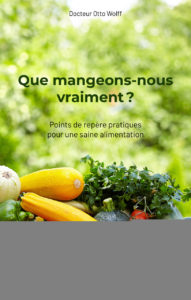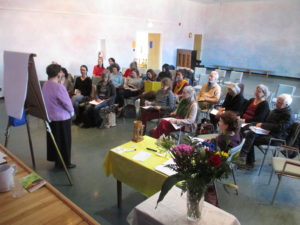26 Mar Eat healthy, Choose Life! Interview with Dr. Daphné von Bach by Michel Dongois
Dr. Daphné von Boch is an anthroposophical doctor who was born in Montreal but presently resides in Switzerland. She carries on the legacy of Dr. Otto Wolff, * having been his closest student and collaborator. In February, at the invitation of Renée Cossette and Arie van Ameringen, Dr. von Boch gave a lecture and workshop on nutrition at the Montreal Rudolf Steiner School. An audience of 50 persons attended her lecture, and 20 individuals participated in the workshop on the following day. Dr. von Boch explained the basis of healthy nutrition, and her suggestions were designed to help individuals make informed choices without being swayed by current fads and contradictions.
How did you come to discover anthroposophy?
I was studying psychology in Argentina, where my family had moved when I was 8 years old, and was intent on discovering the link between the body and the soul. Freudianism, that sees sexuality as being the explanation for everything, was of absolutely no help to me in this quest. I discovered anthroposophy at age 20, thanks to my sister who was attending a Waldorf school at the time. What a revelation it was to learn how a human being continues after death to tread a path begun long before birth, without dissolving into the great All! Suddenly, life took on a whole new meaning; the goal of life on earth was personal development of the individual soul!
After completing my studies in psychology, I discovered anthroposophical medicine during a three-week seminar in Argentina led by Dr. Wolff. Not only did I discover the connection between the body and the soul, but also how they were related to the cosmos. I sensed then and there that this was a revolution I had to be a part of. I then took up the study of official medicine and its anthroposophical counterpart. I practiced medicine for several years in two anthroposophical clinics for the chronically ill. And during that time, I was able to determine that medical care worked much better when the nutritional aspect was included in the treatment.
Where does your interest in nutrition come from?
From my personal experience, both as a patient and as a doctor. At age 21, because of various health issues I was experiencing, I went on a four-week sugarless diet while at the same time taking anthroposophical medical remedies.
What is your opinion on contemporary medicine?
It is a blessing when it is a question of saving lives, of acting immediately to rescue those who are on the verge of dying. But life-saving medicine does not truly heal. Healing requires time. I was disappointed to find that standard medical practice does not really deal with the question of nutrition, or only rarely, as in the case of diabetes. Eating the wrong foods for decades ends up harming the body by poisoning it slowly but surely.
Is there a golden rule as far as nutrition is concerned?
Yes, and that rule is to ask oneself the following question: what is the right food? Eating keeps us alive, therefore, the right foods are those that contain the most life. It is only animals and human beings that have to eat. Plants create their own life substances with light (photosynthesis). When they have no more light, plants immediately cease to create their life substances – carbohydrates. Life is light caught in substance, and it is this life that feeds animals and human beings. Raw foods contain more life that do cooked foods, because as soon as we heat them, we begin to destroy part of the life they contain.
Animals, having already burned up life forces through warmth, movement and consciousness, have less life force than do plants. The worst foods purchased at the supermarket are those that are pre-prepared and pre-cooked. Having been cooked for days, they have lost almost all their life forces. What’s more, they contain all sorts of synthetic additives that our bodies do not recognise. Indeed, the body only recognises natural substances, not those that are made in laboratories. In short, we should consider nutrition from the point of view of the life contained in the foods and not the substances themselves.
How can we make the right choices given the multiplicity of foods available to us?
First of all by becoming clear on the types of foods we are talking about. Generally speaking, they can be classified in three main types, and several of these foods can also belong to more than one category:
– Life-transmitting foods (Lebensmittel, in German): fruits and vegetables, milk and dairy products – organic, because of the better care given to the cows. Milk having a long shelf-life (UTH) is to be avoided, since it is heated to excessive temperatures, which kills all life forces.
Fish also is food full of life; that is why a fish can give birth to hundreds of offspring. Sourdough rye bread also transmits a great deal of life forces. Rye acquires its force by resisting low temperatures as it grows. In Germany, rye bread is called “soldiers’ bread,” since soldiers need maximum strength.
– Health-transmitting foods, with healing qualities (Heilmittel): honey, which is made by bees from nectar, the part of the plant that is closest to the light. Yet honey must be taken in moderation – a maximum of one teaspoonful per day. Natural yogurt, which like sourdough contains lactate, which strengthens the liver and fosters intestinal bacterial growth. And grains, but only if they have kept their germinating force, because then they have retained all of the forces of the living plant through one or even several winters.
– Pleasure foods, (Genussmittel): sugar, coffee, chocolate, black tea, starch, alcohol, etc. In this category, we should try to focus as much as possible on natural choices (plants, milk, butter, meat). We should try to eliminate processed foods (sugar, alcohol, etc.) and ultra-processed foods (sausage, instant foods, soft drinks, pre-prepared meals from the supermarket). Not only has all life completely disappeared from these products, but they contain synthetic substances, artificial colours and preservatives.
You have misgivings concerning vitamin D. Why?
Because it’s a hormone, not a vitamin. Our body already produces its own vitamin D. If we give it more, it is no longer prophylactic in nature, it is an overdose. The tendency nowadays is to consider it a cure-all for any number of health issues, from the head all the way down to the feet.
When we produce our own vitamin D, the necessary calcium is absorbed into the blood. Adding to the amount of vitamin D artificially forces more calcium into the blood stream. This leads to large amounts of calcium being deposited in the arteries and tends to produce arterial sclerosis, even in the arteries located in the brain. When this happens, dementia can result. Vitamin D is prescribed, for example, to guard against osteoporosis in an effort to strengthen the bones. But X-rays show that instead of going into the bones, the calcium becomes lodged in the aorta. It is then not only the body that becomes rigidified, but the entire person, including the mental faculties.
Why do you so often warn against sugar?
In the field of nutrition, sugar is an exception, because it tends to form crystals. And unlike living substances, only dead minerals form crystals. Sugar is “cooked” to the point where it contains no life whatsoever. And being dead, it produces crystals and can no longer be transformed. If we take an apple for example, it will decompose after a certain time due to the activity of bacterial agents which strip it of its own life. But sugar does not decompose any further because it has no life to begin with. Even bacteria cannot live on sugar. Of course sugar does originate from live sources (sugar beets, sugar cane), but it contains no life and retains only dead energy. That is why it creates an illusionof giving strength. A big dose of sugar can give an initial boost of energy; but that is followed by a sense of fatigue because the illusion of strength prompts us to expend too much energy. We then compensate for this fatigue by taking in more sugar, which begins to create a vicious circle leading eventually to addiction. Sugar is a drug that opens the way towards the use of even stronger drugs.
How can we wean ourselves off this drug?
By going on a yearly four-week sugarless diet. During this time, we also have to forego everything that contains sugar, including honey and maple syrup. But fresh fruits are perfectly acceptable. Cutting out sugar in this way may be a drastic measure, but it works! When I went on the diet myself, I experienced a crisis moment between the 10thand 15thday, but by week three I felt fine. At the end of this “detox” period, we find that we don’t crave sugar in the same way we did before, and after several years of going on this four-week sugarless diet, we are no longer addicted. And we have more strength without sugar. Anyone suffering from acute or chronic fatigue, repeated colds or cystitis, allergies or cancer, should undergo a sugarless cure for a minimum of four weeks. Generally speaking, sugar should not be eaten every day, but only on Sundays, so as not to do the body any harm.
Can we counteract the nutritional depletion of the foods we consume?
Yes, by using biodynamic methods to grow our plants, since this allows the plants to absorb more light, and with excellent results. This can be observed in the fact that biodynamically cultivated plants exhibit more of a yellow hue, they are more light-filled, they produce more grain and larger fruit. Take for instance a biodynamically grown tomato; when it is cut open, the juice does not squirt out all over the plate – it remains in the tomato. As for the animals raised on a biodynamic farm, they produce more offspring than those raised by conventional methods because they are overflowing with strength, and they can transmit that strength to other beings.
Now, as for alcohol, it is a harmful beverage, even when produced by biodynamic methods. In former times, alcohol was used as an anesthetic. And indeed, it still is to a lesser degree, when taken in small amounts. It produces a heaviness in us and reduces our awareness of who we are, that awareness that helps us to become better human beings. It distracts us from our true ideals. Cigarettes are worse for us physically speaking, but alcohol is worse on the soul level. As for marijuana, it has the same effects as alcohol in this respect.
I also advise against eating cultivated mushrooms, because they are grown in dark, humid conditions and not on healthy plants full of life forces. Mushrooms contain practically no life; they replace light with darkness. They also contain chitin, the protein found in insects.
And what about meat?
Meat has less life in it than do plants. Eating meat twice a week – fish or beef or chicken – is not a problem, but not twice a day! Eating meat can be of help to individuals who have trouble remaining alert, but for those individuals who have no problem remaining alert, it is best to save meat exclusively for Sunday dinner.
The closer the animal’s constitution is to that of the human being, the more difficult it is for the body to identify the protein as being foreign. The body absorbs it without completely decomposing it. Physiologically speaking, the pig is the animal closest to the human being. The furthest removed is the fish. The body does not recognise proteins that come from the pig, since they are close to human proteins. Therefore, we run the risk of losing a bit of our humanness when we eat pork. This is part of the traditional wisdom of the Jews and the Arabs, who avoid eating pork. Pork meat is also known to be bad for those suffering from rheumatoid issues, because the non-destroyed foreign proteins form deposits in the joints and cause inflammation.
We are better off eating chicken rather than pork, since the chicken is a bird and is further removed from the human being than either the pig or the cow. We should also consider the soul of the animal, and reflect on the spirit that lives behind each animal. Take the goat, for example. The goat is an animal that is never satisfied, that always wants what it doesn’t have. On the other hand, the sheep is satisfied with what it has; asking for nothing, it gives everything: meat, milk, wool. The sheep is healthier than the goat.
You mentioned during your workshop that our society has done outrageous things in the field of nutrition. What do you mean by that?
Just look at the mad cow phenomenon. To force a strictly vegetarian animal, a beast that eats absolutely no animal products, to eat animal meat is pure human madness, and not madness on the part of the cow! Along the same lines, we are now preparing human beings to accept the idea of eating insects. There are already two billion people who consume mealworms and crickets. If we look at the spirit behind insects, we see that insects live in darkness, move like machines and make mechanical-like noise. So what forces do we take in from them? There is however one exception: the honey bee. The bee is yellow in colour, takes its orientation from light, and only touches the earth in order to drink.
Summing up: what to choose, what to avoid?
It is recommended that 30% of what we eat each day should be raw, salads and fruits. Pork is to be avoided, as are shellfish, which only feed on dead carcasses, and also legumes, because they contain a poisonous substance called phasine that is only destroyed by cooking. And even cooked, legumes are difficult to digest and produces methane gas. Nuts, on the other hand, contain a great amount of life and are extremely healthy, except the peanut, which develops to maturity in the darkness of the soil. This is an aberration, since healthy fruit ripens high up in the tree, in full sunlight. Therefore, we should avoid peanuts.
As for eggs, they are concentrated life, where everything is force and has not yet become substance, whereas in the adult rooster, almost all the life forces have become substance. But not only does an egg contain plentiful life forces, it also contains the soul of the animal; and the rooster is a very impassioned animal; hence the aphrodisiac quality of eggs. So, go easy on the eggs for children and teenagers! For adults, one egg per day is fine.
According to you, what is the right attitude to take regarding nutrition?
I can sum it up by quoting Luther: “Be a sinner and sin boldly, but believe even more boldly (Pecca fortiter, sed forties crede).”In other words, eat healthily and with restraint, as suggested above, for six days, and then “sin” on Sundays.
The problem with severe and difficult diets (macrobiotic, vegan, where no animal product is eaten), is that those who follow them spend much more time thinking about the food itself rather than concentrating on the spiritual nourishment the food offers. It is wrong to think that by following a strict diet we can automatically attain access to spiritual perception. For that to happen, one must make a spiritual resolve, a decision that must be constantly renewed. On the other hand, eating only junk food and taking too much vitamin D can impede one’s efforts to access the spiritual world. Therefore, the best thing is to avoid extremes and make nutritional choices that can preserve our health while also supporting our spiritual development.
Livre-1
 *German anthroposophical doctor, researcher in the field of biochemistry (1921-2003). He was a pioneer in the research and development of anthroposophical remedies, and is the principal author of the book considered to be the benchmark in the field of anthroposophical medicine: The Anthroposophical Approach to Medicine.He is also the author of What are we Really Eating? (Available on Amazon. A French translation has just been published in Canada by Les Éditions Perceval: Que mangeons-nous vraiment?)
*German anthroposophical doctor, researcher in the field of biochemistry (1921-2003). He was a pioneer in the research and development of anthroposophical remedies, and is the principal author of the book considered to be the benchmark in the field of anthroposophical medicine: The Anthroposophical Approach to Medicine.He is also the author of What are we Really Eating? (Available on Amazon. A French translation has just been published in Canada by Les Éditions Perceval: Que mangeons-nous vraiment?)

